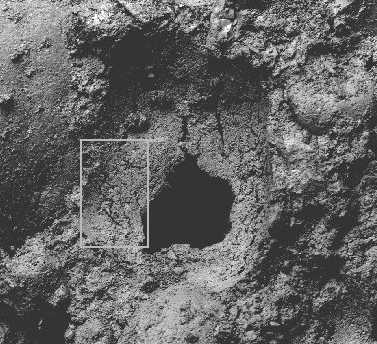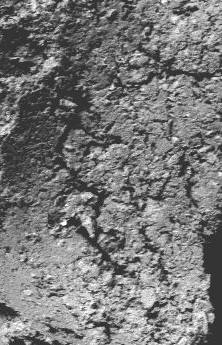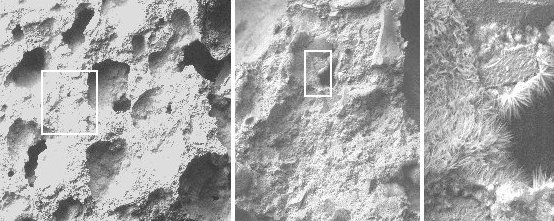
 |
Mud as a humidity buffer for house interiors |
The mud introduced in the previous chapter is a mixture of sand grains of different sizes with clay acting as a cement, clinging in the cracks between the grains.


The scanning electron micrograph (left), shows an area about 1 mm across. The small outlined area is enlarged on the right
The mud has broken so that a rounded sand grain is exposed at the top left. In the centre is the concave space that was occupied by a sand grain that has pulled out. Notice that the clay does not entirely fill the spaces between the grains. This is important both for stability and for good buffering. If many of the sand grains are touching, the mud cannot shrink. Instead, the clay cracks into microscopic fissures, which give it a large accessible surface.
The correct mixing of sand and clay to give a slightly porous structure, with sand grains touching, will give the best moisture buffering and also the best building quality.
Cellular concrete has a rather different structure.

The picture on the left is a broken surface, 2 mm across. The gas bubbles are mostly far apart, with only occasional interconnections. The bulk of the structure is a mass of fibrous calcium aluminosilicate fibres, together with some etched quartz grains. The pictures to the right zoom in on the structure.
The large, isolated voids in cellular concrete give it good thermal insulation but harm its buffer properties. The volume in the voids contributes no moisture capacity and the voids are not so extensively interlinked that they provide an easy diffusion path for moisture from the interior to reach the surface.
All porous materials have a certain capacity for buffering the relative humidity in rooms with less than about one air change per hour. The materials described here are quite good for this purpose but by no means optimised to perform as humidity buffers. Modified muds, and their physical properties, are discussed by Gernot Minke (reference below).
The next chapter compares the performance of several porous building materials as relative humidity buffers.
The mud: about 4 parts sand to 1 of clay by volume, straw added until it got too stiff to mix.
The lightweight concrete: This is made, in a factory, by mixing (rather quickly) slaked lime, Ca(OH)2, with aluminium powder, sand and water. The aluminium reacts with water under alkaline conditions to give hydrogen. The alkaline aluminate solution reacts with silica to give a mass of interlocking needles of calcium aluminium silicates. The material shown here weighed 750 kg/cubic metre
Thanks to Ulrich Schnell of the National Museum's Conservation Department, and to The Conservation School in Copenhagen, for the micrographs.
Gernot Minke, 'Materialkennwerte von Lehmbaustoffen', Bauphysik 17 (1995) 124-130.

This work is licensed under a Creative Commons Attribution-Noncommercial-No Derivative Works 3.0 License.